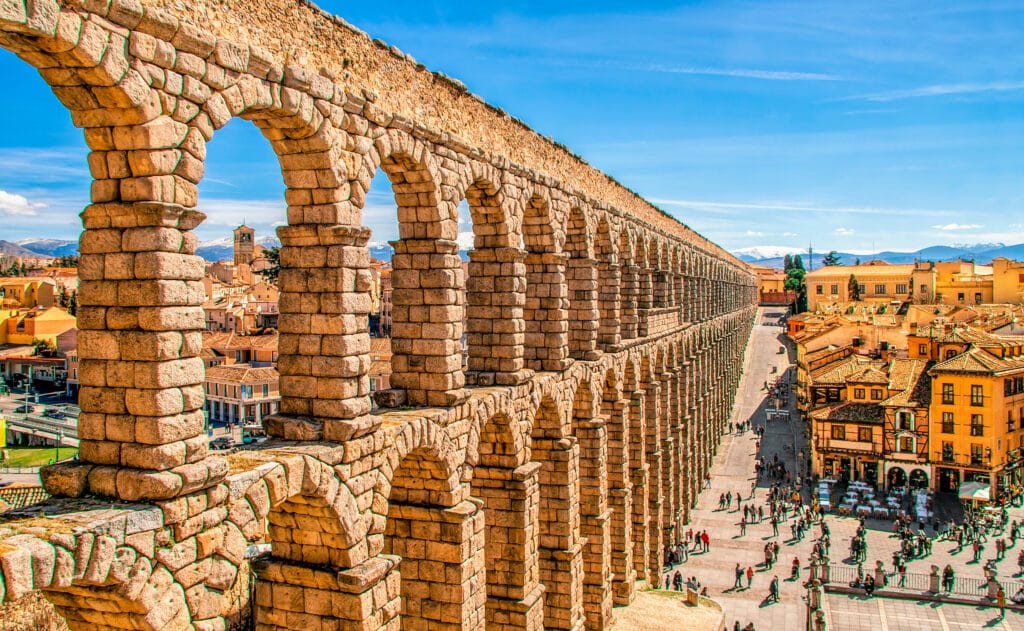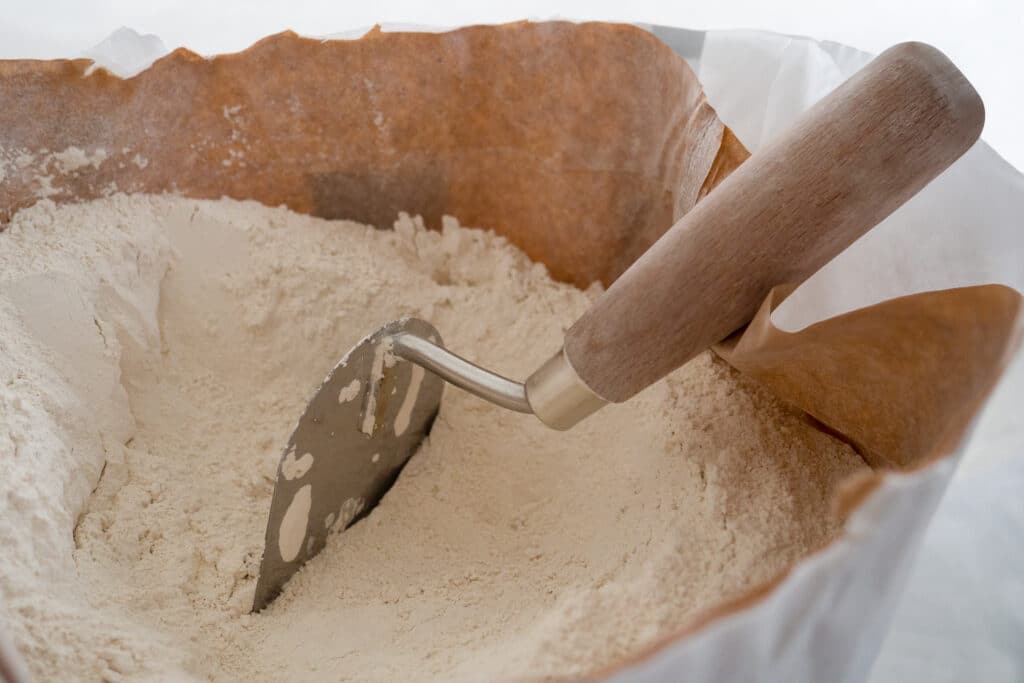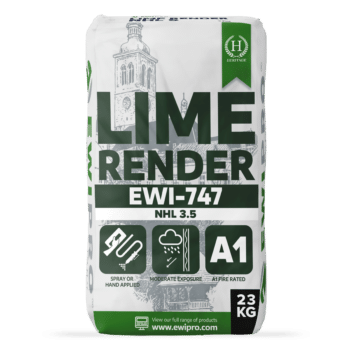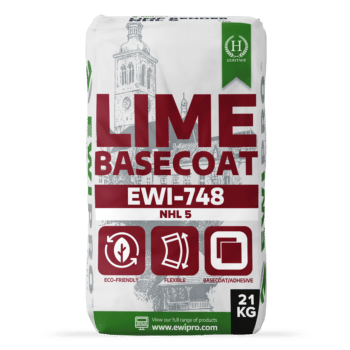What is Lime Render?
Table of contents
- Lime rendering origins
- Non-hydraulic lime
- Why use lime render?
- Three-coat lime render
- How to apply one-coat lime render
Lime render is an innately natural product and our new Lime Render will form the crux of the heritage range of products. The heritage range harks back to traditional building techniques and styles, with a great emphasis on environmental and ecological sustainability. At EWI Store, sustainability is at the forefront of our consciousness. The introduction of a heritage range deepens our commitment to sustainable practices. Moreover, this is not just limited to the transactional stage of the process; lime renders and its lifespan is intrinsically linked with lower embodied and operational carbon.
Lime rendering origins
The first mentions of lime mortar date back to 6,500 BC in the Indus Valley, with further records mentioning lime render around 2,500 BC in Egypt. The process of creating lime render back then was incredibly simple as a combination of lime and sand would react with carbon dioxide and proceed to harden. This would form limestone. Roman engineers took this process further by adding volcanic ash or brick dust, allowing the mixture to harden at an accelerated rate. The resulting mixture was hydraulic mortars.
Hydraulicity is the ability of a mixture to set underwater without exposure to air. As a result, Romans could use the new hydraulic lime render in cisterns and aqueducts. The development was crucial to the growth of civil engineering and consequent technological advancements. Roman aqueducts could ferry water across whole cities, supplying clean water to the whole city.
Testaments to the durability of lime render are still seen today, as many Roman aqueducts are still standing. Moreover, the Acqua Vergine still acts as a functioning aqueduct, bringing water to certain Roman fountains.

- Aqueduct in Segovia
Pyramids of Giza
Lime render and cement
Lime renders nowadays comprise hydraulic lime, water, and an aggregate such as sand. It is beneficial for the sand to be ultra-fine to prevent any issues with consistency upon mixing. As a result of its origins, lime render is primarily for the conservation of old buildings and in the construction of new buildings that mimic heritage features. The advent of Portland cement in the 19th century supplanted lime render as the primary option in construction. However, cementitious mixtures tend to be extremely durable, to the point of being inflexible. They are also much heavier, therefore not suitable for the refurbishment of older, softer building materials.
Cement tends to be far less breathable; it evaporates water less than bricks, for example, exasperating any dampness issues. Spalling is an issue that affects cement and concrete plasters as they are susceptible to freeze-thaw cycles. These cycles cause rapid expansion and contraction. Chunks of the material can subsequently delaminate from the substrate.
Hydraulic lime
Lime splits into hydraulic and non-hydraulic lime and as established, hydraulicity is the ability to set underwater without exposure to air. Natural hydraulic lime (NHL) comes in three strength grades, labelled as feebly, moderately, and eminently hydraulic. The number indicates the compressive strength of the relative lime. Hydraulic lime is produced from limestones with naturally occurring impurities. It sets through the process of hydrolysis, a chemical reaction in which a molecule of water breaks one or more chemical bonds. In comparison to non-hydraulic lime, it has a faster initial set and greater compressive strength. Due to the faster set, it sets in extreme conditions like underwater.
As hydraulic lime reacts with water, the product is supplied as a dry powder to building sites. The process of producing a usable lime render on-site includes dry-slaking.
| Type of NHL | Description | Masonry Type | Exposure | Setting | Use |
|---|---|---|---|---|---|
| NHL 2 | Feebly hydraulic | Soft, permeable masonry | Minimal | Softer, slow setting | Internal with concern for the conservation of soft & deteriorating stones and bricks |
| NHL 3.5 | Moderately hydraulic | Medium density masonry | Moderate | Regular setting | Use when NHL 2 and NHL 5 are not specifically required |
| NHL 5 | Eminently hydraulic | Dense, impermeable density | Severe | Stronger, faster setting | Dense, durable, or impermeable materials |
Hardening
Hydraulic Lime hardens through a combination of carbonation and a chemical reaction with water, known as hydraulic action. There are three drying processes for hydraulic lime:
- Initial set: The initial set, when the lime mortar or render starts to firm up and lose its plasticity, can take anywhere from a few hours to a day or two, depending on the specific hydraulic lime used and the conditions.
- Final set: The final set, when the lime mortar or render has hardened enough to be self-supporting, usually occurs within 1 to 7 days, depending on the hydraulic lime class, mix proportions, and environmental conditions.
- Full cure: Although hydraulic lime hardens more quickly than non-hydraulic lime, it still takes time to achieve its full strength and cure completely. This can range from a few weeks to several months, with strength continuing to develop even after a year.
Non-hydraulic lime
Non-hydraulic lime differs in several ways, perhaps most noticeably in the way it looks. It comes in the form of white putty and is also manufactured from limestone. However, it is burned in a kiln and sets by a completely different chemical process. That process is carbonation, therefore it requires air to draw the carbon particles in. As the chemical process is different, non-hydraulic lime cannot be set underwater, is much softer for longer, and sets much slower than hydraulic lime. As the lime is much softer, it allows for sufficient movement in conservation projects, however, it can be much harder to use on-site. The initial outlay savings are therefore offset by the increased labour costs.
The absorption of carbon dioxide is important for lime renders. Non-hydraulic lime render is particularly adept at absorbing carbon dioxide as it requires it to set properly. The material absorbs more carbon dioxide during the longer setting period. Consequently, taking far more out of the atmosphere.
The installation timeframe and difficulty of use are just some of the reasons why hydraulic lime is better than non-hydraulic lime. Hydraulic lime provides a faster initial set and greater compressive strength. When working, hydraulic lime is similar to cement therefore less specialised skill is required.


Suction control and bonding
It is vitally important to check the suction of the substrate before application; either extreme suction can result in a weak bond caused by rapid de-maturing of the lime render. The final result is a weak and powdery façade leading to later failure and separation.
Either way, wetting stabilises a substrate. Dense or impervious masonry requires minimal misting, whilst very porous surfaces require far more wetting. A certain amount of suction is required for lime render to adhere and stiffen. The amount of saturation required is determined by a skilled installer.
Why use lime render?
One of the primary reasons for using lime render is breathability. The breathability of lime render refers to its ability to allow water vapour to pass through its structure, facilitating the movement of moisture in and out of a building’s walls. This permeability is a crucial characteristic of lime render, providing several advantages over less breathable materials, such as cement-based renders.
Factors Contributing to Breathability
- Porosity: Lime render’s breathability is primarily due to its porous structure. The pores within the material create channels for water vapour to move through, allowing moisture to escape from the interior of a building and evaporate on the surface. This porosity is influenced by several factors, including the type of lime, the sand used in the mix, and the application techniques.
- Hygroscopicity: Lime render is hygroscopic, meaning it can absorb and release moisture from the surrounding environment. This characteristic helps regulate humidity levels within a building, as the material can take in moisture when the air is damp and release it when it is dry. The hygroscopic nature of lime render is an essential component of its breathability.
- Capillarity: Capillarity refers to the movement of moisture through a material due to the surface tension of the liquid and the adhesive forces between the liquid and the material’s structure. In lime render, capillary action facilitates the transport of moisture through the material, allowing it to evaporate on the surface and further enhancing its breathability.
Three-coat lime render
Three-coat lime render is for traditional lime render which is a highly skilled process as you have to be able to “read” the render and decide when it is dry enough for the next coat.
The starting point for any rendering project is the selection of your product. You must also consider the surface of the substrate as some substrates may be more structurally sound than others. The considerations for the products revolve around strength, performance, and workability.
As with any rendering, the substrate needs to be cleaned and free of all dust. A sound mechanical key is also crucial as it aids adhesion, therefore any overly smooth substrates should be scraped.
Lime render is notoriously temperamental, especially in its infancy. It can fail for a multitude of reasons, including excessive shrinkage, drying back too quickly, or weather damage whilst the render is still setting. Shrinkage is inevitable with lime render, however, excessive shrinkage is combated with a plasterer’s float. Drying out too quickly and carbonising are also very different. Extremes of weather also have an impact on the durability and long-term performance of lime render. Therefore, take precautions like sheltering the area, especially in the first 14 days of the setting process.
Whilst three-coat lime render is traditional, it is an incredibly laborious process. At EWI Store, we stock a one-coat NHL 3.5 lime render, which offers the same breathability and performance, paired with a much easier installation process.
-
Lime Render NHL 3.5 (EWI-747) – 23kg
Rated 5.00 out of 5£19.94 Incl. VAT£16.62 Excl. VAT -
Lime Basecoat NHL 5 (EWI-748) – 21kg
£27.94 Incl. VAT£23.28 Excl. VAT
How to apply one-coat lime render
One-coat lime render is applied in one pass and levelled with a straight edge. Approximately 1.5 hours after application, use a sponge float the surface to create a light, creamy texture. Consequently, a steel trowel creates a smooth finish. There should still be no overworking as it can lead to cracking and excessive shrinkage.
Points to remember about lime render
There are several points to take away when you think about lime render:
- Mortars should be sacrificial
- Mortar is softer than masonry
- Softer lime mortar will absorb & evaporate
- Breathable
- Does not leach damaging chemicals
- Accommodate movement & thermal expansion
- Mortar should be as soft as it needs to be but no softer
- Lime absorbs carbon dioxide
- Lower embodied and operational carbon
Lime render is a fantastic option for renovation projects on older properties. If you have any other questions about lime render, leave us a comment!
Facebook
Twitter
LinkedIn
Your cart
Trade Account Login

We use cookies on our website to give you the most relevant experience by remembering your preferences and repeat visits. By clicking “Accept All”, you consent to the use of ALL the cookies. However, you may visit "Cookie Settings" to provide personalised consent.
Manage consent
Privacy Overview
This website uses cookies to improve your experience while you navigate through the website. Out of these, the cookies that are categorized as necessary are stored on your browser as they are essential for the working of basic functionalities of the website. We also use third-party cookies that help us analyze and understand how you use this website. These cookies will be stored in your browser only with your consent. You also have the option to opt-out of these cookies. But opting out of some of these cookies may affect your browsing experience.
Necessary cookies are absolutely essential for the website to function properly. These cookies ensure basic functionalities and security features of the website, anonymously.
| Cookie | Duration | Description |
|---|---|---|
| __stripe_mid | 1 year | This cookie is set by Stripe payment gateway. This cookie is used to enable payment on the website without storing any patment information on a server. |
| __stripe_sid | 30 minutes | This cookie is set by Stripe payment gateway. This cookie is used to enable payment on the website without storing any patment information on a server. |
| _GRECAPTCHA | 5 months 27 days | This cookie is set by the Google recaptcha service to identify bots to protect the website against malicious spam attacks. |
| apbct_cookies_test | session | CleanTalk sets this cookie to prevent spam on comments and forms and act as a complete anti-spam solution and firewall for the site. |
| apbct_page_hits | session | CleanTalk sets this cookie to prevent spam on comments and forms and act as a complete anti-spam solution and firewall for the site. |
| apbct_prev_referer | session | Functional cookie placed by CleanTalk Spam Protect to store referring IDs and prevent unauthorized spam from being sent from the website. |
| apbct_site_landing_ts | session | CleanTalk sets this cookie to prevent spam on comments and forms and act as a complete anti-spam solution and firewall for the site. |
| apbct_site_referer | 3 days | This cookie is placed by CleanTalk Spam Protect to prevent spam and to store the referrer page address which led the user to the website. |
| apbct_timestamp | session | CleanTalk sets this cookie to prevent spam on comments and forms and act as a complete anti-spam solution and firewall for the site. |
| apbct_urls | 3 days | This cookie is placed by CleanTalk Spam Protect to prevent spam and to store the addresses (urls) visited on the website. |
| AWSALBCORS | 7 days | This cookie is managed by Amazon Web Services and is used for load balancing. |
| cookielawinfo-checkbox-advertisement | 1 year | Set by the GDPR Cookie Consent plugin, this cookie is used to record the user consent for the cookies in the "Advertisement" category . |
| cookielawinfo-checkbox-analytics | 11 months | This cookie is set by GDPR Cookie Consent plugin. The cookie is used to store the user consent for the cookies in the category "Analytics". |
| cookielawinfo-checkbox-functional | 11 months | The cookie is set by GDPR cookie consent to record the user consent for the cookies in the category "Functional". |
| cookielawinfo-checkbox-necessary | 11 months | This cookie is set by GDPR Cookie Consent plugin. The cookies is used to store the user consent for the cookies in the category "Necessary". |
| cookielawinfo-checkbox-others | 11 months | This cookie is set by GDPR Cookie Consent plugin. The cookie is used to store the user consent for the cookies in the category "Other. |
| cookielawinfo-checkbox-performance | 11 months | This cookie is set by GDPR Cookie Consent plugin. The cookie is used to store the user consent for the cookies in the category "Performance". |
| ct_checkjs | session | CleanTalk–Used to prevent spam on our comments and forms and acts as a complete anti-spam solution and firewall for this site. |
| ct_fkp_timestamp | session | CleanTalk sets this cookie to prevent spam on the site's comments/forms, and to act as a complete anti-spam solution and firewall for the site. |
| ct_pointer_data | session | CleanTalk sets this cookie to prevent spam on the site's comments/forms, and to act as a complete anti-spam solution and firewall for the site. |
| ct_ps_timestamp | session | CleanTalk sets this cookie to prevent spam on the site's comments/forms, and to act as a complete anti-spam solution and firewall for the site. |
| ct_sfw_pass_key | 1 month | CleanTalk sets this cookie to prevent spam on comments and forms and act as a complete anti-spam solution and firewall for the site. |
| ct_timezone | session | CleanTalk–Used to prevent spam on our comments and forms and acts as a complete anti-spam solution and firewall for this site. |
| elementor | never | This cookie is used by the website's WordPress theme. It allows the website owner to implement or change the website's content in real-time. |
| viewed_cookie_policy | 11 months | The cookie is set by the GDPR Cookie Consent plugin and is used to store whether or not user has consented to the use of cookies. It does not store any personal data. |
Functional cookies help to perform certain functionalities like sharing the content of the website on social media platforms, collect feedbacks, and other third-party features.
| Cookie | Duration | Description |
|---|---|---|
| __zlcmid | 1 year | This cookie is used by Zendesk live chat and is used to store the live chat ID. |
| bcookie | 2 years | LinkedIn sets this cookie from LinkedIn share buttons and ad tags to recognize browser ID. |
| bscookie | 2 years | LinkedIn sets this cookie to store performed actions on the website. |
| lang | session | LinkedIn sets this cookie to remember a user's language setting. |
| lidc | 1 day | LinkedIn sets the lidc cookie to facilitate data center selection. |
| UserMatchHistory | 1 month | LinkedIn sets this cookie for LinkedIn Ads ID syncing. |
Performance cookies are used to understand and analyze the key performance indexes of the website which helps in delivering a better user experience for the visitors.
| Cookie | Duration | Description |
|---|---|---|
| __utma | 2 years | This cookie is set by Google Analytics and is used to distinguish users and sessions. The cookie is created when the JavaScript library executes and there are no existing __utma cookies. The cookie is updated every time data is sent to Google Analytics. |
| __utmb | 30 minutes | Google Analytics sets this cookie, to determine new sessions/visits. __utmb cookie is created when the JavaScript library executes and there are no existing __utma cookies. It is updated every time data is sent to Google Analytics. |
| __utmc | session | The cookie is set by Google Analytics and is deleted when the user closes the browser. It is used to enable interoperability with urchin.js, which is an older version of Google Analytics and is used in conjunction with the __utmb cookie to determine new sessions/visits. |
| __utmt | 10 minutes | Google Analytics sets this cookie to inhibit request rate. |
| __utmv | 2 years | The __utmv cookie is set on the user's device, to enable Google Analytics to classify the visitor. |
| __utmz | 6 months | Google Analytics sets this cookie to store the traffic source or campaign by which the visitor reached the site. |
| sib_cuid | 6 months | Purechat uses this cookie to send data to purechat.com, to connect visitors to the reservation team and track visitors to stay on portal. |
| SRM_B | 1 year 24 days | Used by Microsoft Advertising as a unique ID for visitors. |
Analytical cookies are used to understand how visitors interact with the website. These cookies help provide information on metrics the number of visitors, bounce rate, traffic source, etc.
| Cookie | Duration | Description |
|---|---|---|
| _ga | 2 years | The _ga cookie, installed by Google Analytics, calculates visitor, session and campaign data and also keeps track of site usage for the site's analytics report. The cookie stores information anonymously and assigns a randomly generated number to recognize unique visitors. |
| _gat_gtag_UA_61069204_2 | 1 minute | Set by Google to distinguish users. |
| _gat_UA-61069204-2 | 1 minute | A variation of the _gat cookie set by Google Analytics and Google Tag Manager to allow website owners to track visitor behaviour and measure site performance. The pattern element in the name contains the unique identity number of the account or website it relates to. |
| _gcl_au | 3 months | Provided by Google Tag Manager to experiment advertisement efficiency of websites using their services. |
| _gid | 1 day | Installed by Google Analytics, _gid cookie stores information on how visitors use a website, while also creating an analytics report of the website's performance. Some of the data that are collected include the number of visitors, their source, and the pages they visit anonymously. |
| _uetsid | 1 day | This cookies are used to collect analytical information about how visitors use the website. This information is used to compile report and improve site. |
| CONSENT | 2 years | YouTube sets this cookie via embedded youtube-videos and registers anonymous statistical data. |
Advertisement cookies are used to provide visitors with relevant ads and marketing campaigns. These cookies track visitors across websites and collect information to provide customized ads.
| Cookie | Duration | Description |
|---|---|---|
| _fbp | 3 months | This cookie is set by Facebook to display advertisements when either on Facebook or on a digital platform powered by Facebook advertising, after visiting the website. |
| ANONCHK | 10 minutes | The ANONCHK cookie, set by Bing, is used to store a user's session ID and also verify the clicks from ads on the Bing search engine. The cookie helps in reporting and personalization as well. |
| fr | 3 months | Facebook sets this cookie to show relevant advertisements to users by tracking user behaviour across the web, on sites that have Facebook pixel or Facebook social plugin. |
| MUID | 1 year 24 days | Bing sets this cookie to recognize unique web browsers visiting Microsoft sites. This cookie is used for advertising, site analytics, and other operations. |
| NID | 6 months | NID cookie, set by Google, is used for advertising purposes; to limit the number of times the user sees an ad, to mute unwanted ads, and to measure the effectiveness of ads. |
| test_cookie | 15 minutes | The test_cookie is set by doubleclick.net and is used to determine if the user's browser supports cookies. |
| uuid | 6 months | MediaMath sets this cookie to avoid the same ads from being shown repeatedly and for relevant advertising. |
| VISITOR_INFO1_LIVE | 5 months 27 days | A cookie set by YouTube to measure bandwidth that determines whether the user gets the new or old player interface. |
| YSC | session | YSC cookie is set by Youtube and is used to track the views of embedded videos on Youtube pages. |
| yt-remote-connected-devices | never | YouTube sets this cookie to store the video preferences of the user using embedded YouTube video. |
| yt-remote-device-id | never | YouTube sets this cookie to store the video preferences of the user using embedded YouTube video. |
| yt.innertube::nextId | never | This cookie, set by YouTube, registers a unique ID to store data on what videos from YouTube the user has seen. |
| yt.innertube::requests | never | This cookie, set by YouTube, registers a unique ID to store data on what videos from YouTube the user has seen. |
Other uncategorized cookies are those that are being analyzed and have not been classified into a category as yet.
| Cookie | Duration | Description |
|---|---|---|
| _clck | 1 year | No description |
| _clsk | 1 day | No description |
| _uetvid | 1 year 24 days | No description available. |
| AnalyticsSyncHistory | 1 month | No description |
| apbct_pixel_url | session | No description |
| apbct_visible_fields_0 | session | No description |
| apbct_visible_fields_1 | session | No description |
| apbct_visible_fields_10 | session | No description |
| apbct_visible_fields_2 | session | No description |
| apbct_visible_fields_3 | session | No description |
| apbct_visible_fields_4 | session | No description |
| apbct_visible_fields_5 | session | No description |
| apbct_visible_fields_6 | session | No description |
| apbct_visible_fields_7 | session | No description |
| apbct_visible_fields_8 | session | No description |
| apbct_visible_fields_9 | session | No description |
| ct_checked_emails | session | No description |
| ct_has_scrolled | session | No description |
| ct_mouse_moved | session | No description |
| ct_screen_info | session | No description |
| ictf_master | never | No description available. |
| li_gc | 2 years | No description |
| m | 2 years | No description available. |
| SM | session | No description available. |
| testinfinitycookie | session | No description |
| woocommerce_show_tax | 7 days | No description available. |
| wp_woocommerce_session_c5ac76b408021294cb56bcc27eddf8a1 | 2 days | No description |


 Pyramids of Giza
Pyramids of Giza

14 thoughts on “What is Lime Render?”
Pretty comprehensive but it’s a lot to digest. What’s the main reason I should use lime render? We own a small thatched cottage
Hi Jerry, definitely the breathability. Building can accumulate a lot of natural moisture and condensation, therefore, through a combination of breathable walls and ventilation, it needs to get out. Lime based products are excellent for that
I have an old cottage and I think it is lime render on it. Is there an obvious way to tell they type or render it has. Ideally want to replace it like for like!
Thanks in advance
Hi Neil, a visual inspection is usually easiest; lime render will be more textured and less uniform, and may have small cracks. You can also perform a chemical test on a very small area as lime render bubbles under the presence of acid. Probably best to contact an expert and ask them to inspect it for you. EWI Pro’s Technical Team can help!
can you use it inside as well?
Hi Luke, absolutely, lime render is ideally suited to indoor use as it’s aesthetically pleasing, breathable, and anti fungal by nature.
Hi,
I am planning on stripping off the cement render on the back of my house and then adding wood fibre insulation boards as a thermal layer and then finishing with your lime render products.
I don’t have the skills / talent to do this myself! So I am looking to get some quotes. The area is approximately 45m2. Do you have an approx price that this should cost so I can make sure the installer isn’t trying it on when they quote?
Thanks
Roger
Hi Roger, we don’t stock wood fibre insulation boards so can’t quote on that portion. However, you’ll need both our Lime Basecoat and Lime Render, wherein the yield for both is 15 kg/m2 per cm thickness. It would be best to contact our sales team as they can do a calculation for the material costs. There will obviously be labour costs that we can’t quote for, but can recommend a trusted installer. The number for our team is 0203 3974067
What’s the working time for the Lime Render?
Hi Jim, working time is 60 minutes once you’ve finished kneading so it’s important to work in smaller batches.
Recently used this on my farmhouse renovation internally. Had really thick masonry walls so needed something breathable. Levelled it with the render then basecoat to attach the wood fibre and then finished with the render. Looks really good!
Hi Henry, that’s great to hear, sounds like the combination of render, basecoat, and wood fibre provide a breathable internal facade.
Do you need to paint it with lime paint?
Hi Lucinda, you don’t need to! Lime render works as the final finish.